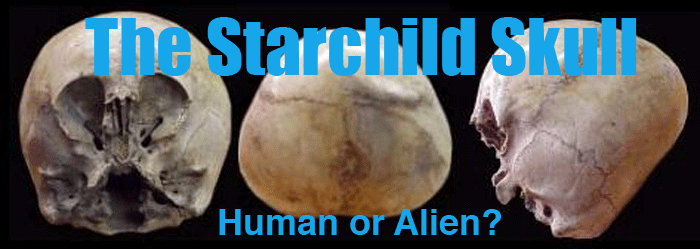
There's so much junk on the web. You don't know what is real or hype.
When I first saw photographs of the oddly shaped "Starchild skull" I thought there could be only two possibilities. It was either a skull from a deformed baby (since no adult could survive with such a distorted head) or it was an unfamiliar animal.
 Of course, with a name like "Starchild" I immediately thought of the round headed, narrow jawed images of so-called "Grey Aliens" -- made famous by Whitley Streiber's book cover [right] on Communion. But that was a distant third possibility for sure. I figured that time, the scrutiny by anthropologists and advances in science would debunk this bit of "web legend", much like the giant skeletons that were created in Photoshop [below, right] and touted by the Pravda News Service (Russia) as "real".
Of course, with a name like "Starchild" I immediately thought of the round headed, narrow jawed images of so-called "Grey Aliens" -- made famous by Whitley Streiber's book cover [right] on Communion. But that was a distant third possibility for sure. I figured that time, the scrutiny by anthropologists and advances in science would debunk this bit of "web legend", much like the giant skeletons that were created in Photoshop [below, right] and touted by the Pravda News Service (Russia) as "real".
But I was wrong.
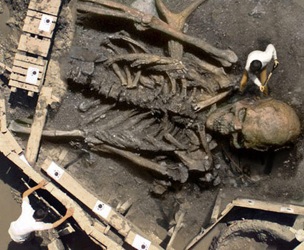 Recent science has made analysis of DNA from ancient bone fragments a possibility and the initial results for this highly unusual skull have forced that third possibility -- that it is extraterrestrial -- to the front.
Recent science has made analysis of DNA from ancient bone fragments a possibility and the initial results for this highly unusual skull have forced that third possibility -- that it is extraterrestrial -- to the front.
Of course, life is never simple. The analysis didn't show that the Starchild skull was a space alien since the study of DNA is done by comparing new samples with old samples of genetic material. We don't have any alien DNA of file. Instead, the results revealed that the Starchild had a distinctly human mother but a non-human father. In short, it was what scientists call a hybrid.
We'll get to the complex science and a detailed analysis of the Starchild skull, but first lets get some obvious facts established.
The idea of a human-alien hybrid is a well established idea. The Bible, in Genesis 6:4 states:
There were giants in the earth in those days; and also after that, when the sons of God came in unto the daughters of men, and they bare children to them, the same became mighty men which were of old, men of renown.More recent hybrid revelations are detailed in Zecharia Sitchin's books, based on his translations of Sumerian scripts like the Atra Hasis and the Ennuma Elish, in which the ancient people describe how modern humans were created by mixing the genes of the "Gods" and primitive human ancestors to create a race of intelligent ancient workers. These "gods" were called the Anninuki and they allegedly came from another planet called Nibiru. Call it science fiction but this story is over 6000 years old!
While the Starchild skull is only 900 years old, its piculiarities suggest some ongoing interaction between our human race and an unknown species.
Background
The Starchild skull was found 80 years ago in a remote cave in Mexico. A teenage American girl from El Paso was visiting her family in the Copper Canyon region, about 100 miles south of Chihuahua, and discovered the remains of two individuals lying on their back, covered by just a few inches of dirt. One of the skeletons was small, like that of a child, and had a oddly shaped skull.
Because of the local customs concerning respect (and fear) for the dead, the young girl was afraid to tell the villagers about her discovery. She hid the two sets of skeletons in an ravine while she made plans to take them back to El Paso and donate them to her school for study.
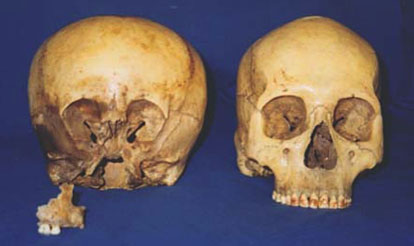
Before she could move them, a torrential rain flooded the ravine and washed the bones away. Two days later she found the skulls and some of the other bones but they had been damaged and broken by tumbling in the flash flood along with the mud and stones. The oddly shaped skull had lost its lower jaw completely [above] and half of the upper jaw was missing. The other skull had lost only its lower jaw bone.
The girl managed to sneak both skulls back to her home in El Paso and kept them for the duration of her life as souvenirs of her visit to Mexico. She had given no special significance to the oddly shaped skull, thinking it was a natural deformity of some kind.
In the 1990s, when the girl passed away, the skulls came into the possession of Ray and Melanie Young, also from El Paso. Coincidentally, Melanie had been a neonatal nurse and was familiar with many natural deformities. She quickly recognized that both the number and type of anomalies appearing on the deformed skull were not the result of any known pathological condition.
The Youngs sought expert help with an analysis of the skulls and were referred to Lloyd Pye, who had the means and contacts to perform various tests on these two artifacts.
Step One: X-Rays
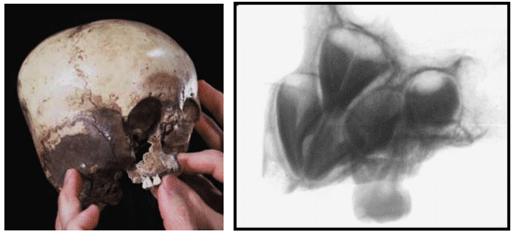
Lloyd first arranged for both skulls to be x-rayed. This revealed that the portion of the upper jaw of the deformed skull had several impacted teeth (showing up at the 5 dark globs in the x-ray image [above right] and suggested that the skull belonged to an individual who died at about 5 or 6 years old.
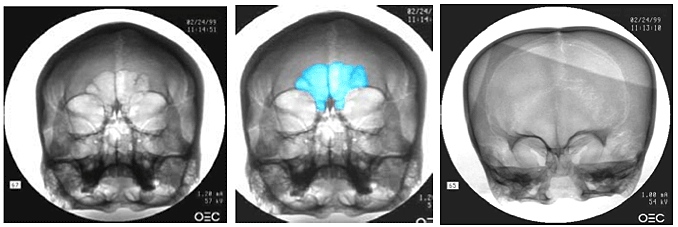
The next obvious anomoly was the frontal sinus regions. The human skull [abov: left and center] showed typical frontal sinuses between the eye sockets. The deformed skull had no trace of frontal sinuses, not even vestigial bumps indicating where its sinuses might have attempted to grow. This is considered extremely unusual. Considered vital for screening dust and particles from reaching the lungs, only about 5% of humans are born without frontal sinuses.
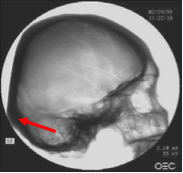 Meanwhile, the second skull was shown to have been from an adult woman and exhibited the classic flat shape of "cradle-boarding." This ancient practice consisted of binding an infant's head against a board so that the shape of the skull would be elongated. It is still practiced in some African and Sourh American cultures and is thought to make the child appear more like deity. Meanwhile, the second skull was shown to have been from an adult woman and exhibited the classic flat shape of "cradle-boarding." This ancient practice consisted of binding an infant's head against a board so that the shape of the skull would be elongated. It is still practiced in some African and Sourh American cultures and is thought to make the child appear more like deity.Whether "natural" or artificially shaped, the royal family of Egypt, who were considered deities, exhibited the same elongated heads as far back as the second millennium BCE. Pictured here [below A]is Nefertiti, wife of the Egyptian Pharaoh Amenhotep IV (later Akhenaten), and mother-in-law of the Pharaoh Tutankhamun. Many fine examples of artificially deformed, "bound" [bottom, B] or "boarded" [bottom, C] skulls have been recovered from Mexico and Peru. 
|
So, was the Starchild cradle boarded?
Both skulls have been carbon-14 dated to 900 BCE. This was an era during which cradle-boarding was apparently in vogue for Central and South American Indians. Since both individuals in the cave were contemporaries, it might well be assumed that the Starchild's deformities were from this same practice. However, upon examining the skulls we note that there are some problems with this theory.
Usually an infant was bound by string or fabric to a board with the head facing forward, the angle of sight horizontal and the neck slightly hyper-flexed (raised) to make breathing easy and unobstructed. We see this in the position of the flat area of the human skull [below, left]. But if we rotate the Starchild's skull to align with the flat area of the skull we see that the eyes look down and, more importantly, the neck is tilted in such a way that the airway would be blocked.
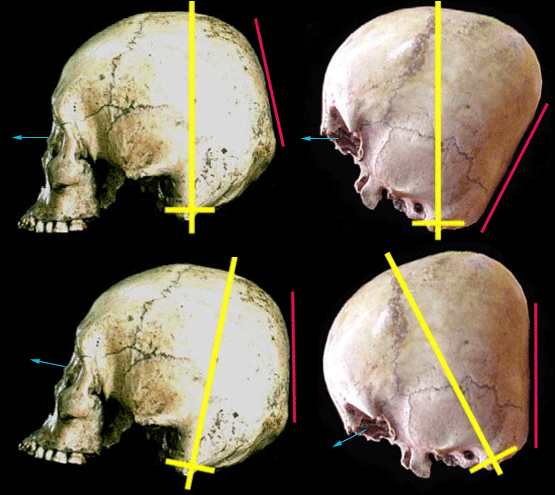
Although there does appear to be a somewhat flat surface at the rear of the Starchild's skull, a close examination reveals it to be natural with many undulating features not normally seen in a cradle boarded skull.
The brain capacity of Starchild is estimated to be 1600 cubic centemeters -- a good 200 cm more than a human. So was Starchild more intelligent?
Is there any known disease or pathology that could cause this?The answer is yes... and no. There is a well known condition called hydrocephalus, literally "water on the brain," in which the cerebral spinal fluid that normally bathes the brain and spinal chord becomes obstructed and builds up pressure inside the skull. This condition can happen to the fetus inside the womb or can occur in early childhood. The result is that the infant's skull, which has not fully formed or hardened, expands to accommodate the excess fluid.

The human skull is made of plates that are separated by cracks or sutures. These sutures allow the skull to expand as the brain grows. They only fuse during later adult life. Infants and children suffering from hydrocephalus [above, left] typically have a round -- almost spherical -- shaped skulls as the fluid easily separates and expands the sutures.
The Starchild skull is slightly heart shaped. The skull expands on both sides of the saggital (center) suture. Examination of this suture shows that it is not fused and so could not restrict the expansion if it were caused by a build up of cerebral spinal fluid. This suggests that the shape of the skull was not caused by spinal fluid.
Another problem with attributing these deformities to hydrocephalus is the eye sockets. Hydrocephalus does not usually distort the shape of the eyes or bony orbits. Indeed children with this disorder have normal looking faces (see image above).
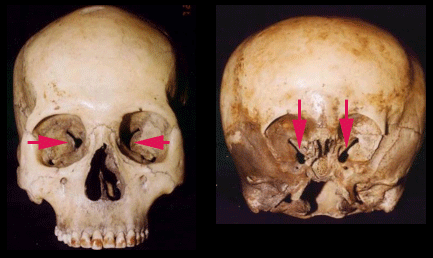 But the Starchild's eyes are extremely unusual. Normal human eye sockets are 2" deep and cone-like, with the optic nerve and the foramen openings (holes for nerves connecting the eyes to the brain) at the farthest point inside. The Starchild's sockets are 0.7" deep, and the optic nerves and foramens are located further down and closer to the inner base of the nose. The surfaces of the Starchild's eye sockets appear perfectly smooth. No shifts in their terrain are evident to human eyes. Yet very subtle shifts are there, and they are exactly alike (i.e. bilateral) in each socket, which can be felt with a fingertip. Such incredible symmetry is highly unlkely to arise from a developmental disease and is most likely genetically determined.
But the Starchild's eyes are extremely unusual. Normal human eye sockets are 2" deep and cone-like, with the optic nerve and the foramen openings (holes for nerves connecting the eyes to the brain) at the farthest point inside. The Starchild's sockets are 0.7" deep, and the optic nerves and foramens are located further down and closer to the inner base of the nose. The surfaces of the Starchild's eye sockets appear perfectly smooth. No shifts in their terrain are evident to human eyes. Yet very subtle shifts are there, and they are exactly alike (i.e. bilateral) in each socket, which can be felt with a fingertip. Such incredible symmetry is highly unlkely to arise from a developmental disease and is most likely genetically determined.

The upper ledges of human eye sockets are rounded [above, left], feeling to the hand like a soda straw. The Starchild's upper sockets come to an edge, not sharp enough to cut, but thin in every way.

Humans have an inner ear which we use to determine what is up and down, to balance ourselves and to detect left - right movement. It is essential to our existence on this gravity planet. The Starchild has an enormous inner ear, several times larger than that of a human. Why? Perhaps it was also many times more sensitive to small changes of position and movement. The location of the ear hole is also different in the Starchild, being lower and more towards the front of the skull. These types of deformities defy explanation.

The cheek bone (the zygomatic arch) protrudes from the face in humans [above,left(purple)] but the cheek bones of the Starchild are unusually small and recessed from the skull. Together with the pieces of the upper jaw, we can see that Starchild's lower face is much smaller than a normal human. The artist's rendering on the right indicates what Starchild might have looked like.
But what about the DNA?
We could summarize many more important anatomical differences of the Starchild skull but these would be meaningless if the DNA turned out to be human. As some scientists have argued, the skull could be an individual who suffered from multiple diseases or afflictions but is still 100% human. Why does LLoyd Pye believe this skull is... something else?
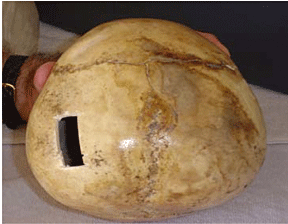 Lloyd began DNA testing about 10 years ago using material extracted from various parts of the skull and teeth. Although science had made some spectacular breakthroughs in profiling DNA, the technology has only recently been able to allow a detailed analysis from a very small sample.
Lloyd began DNA testing about 10 years ago using material extracted from various parts of the skull and teeth. Although science had made some spectacular breakthroughs in profiling DNA, the technology has only recently been able to allow a detailed analysis from a very small sample.
Perhaps some readers of this article will remember that a lab once reported that the Starchild was nothing more than a human. This was an error based on incomplete testing. It did, however, discourage Lloyd as the media seemed determined to squash any hint that the Starchild could be extraterrestrial. Lloyd himself admitted that he wished he had not named the skull "the Starchild" as this lable seems to have invited ridicule from scientists who are stuck in the mainstream paradigm. This also made it extremely difficult to find a professional laboratory willing to test the DNA and possibly have their reputation associated with any controversial results.
Nevertheless, in 2003 Lloyd did find a laboratory, Trace Genetics, willing to let the truth of science prevail. They opted to take a rectangular "window" of the cranium bone and extract the DNA. The window of bone was cut into four smaller pieces for testing purposes. One was put into a test tube filled with EDTA, and that was put into a rocker arm. A similar piece of bone from the human was put in a rocker arm beside it. In one week the EDTA would entirely dissolve normal human bone, which it did with the human from the mine tunnel. However, the Starchild's bone did not dissolve at all, not in one week and not in one month. It had to be dissolved by a very powerful detergent called 'Tween 20. This was another clear indication that the Starchild was something other than entirely human because no other human bone required such handling.
The surprising results!Even before the DNA was extracted, the team cutting the window of skull bone had some unexpected discoveries. The thickness of the skull was less than normal but the strength was far greater than normal human skull tissue. It was more like tooth enamel. And when it was viewed under a microscope it was found to contain interwoven fibers -- like rebar in cement -- that had never been seen before!
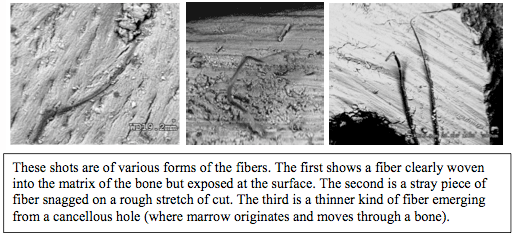
Because of the CSI television shows, nearly everyone everywhere knows at least the fundamentals of how DNA is extracted and squeezed into gel sheet strips to reveal the specific DNA patterns of victims or suspects of crimes. The same held for the human and the Starchild. Their DNA was extracted and then primers were applied to those extractions. Primers are man-made strings of base pairs from a few hundred to a few thousand long. They can be imagined as genetic keys that fit into extremely specific locks. If human-based primers find corollaries in an unknown batch of DNA, there can be absolutely no doubt whatever that the unknown batch came from a human. And, likewise, if human-only primers do not find corollaries in a batch, it is not human.
Once the human's DNA and the Starchild's DNA were recovered and ready for testing, the process was straightforward. Both samples were analyzed for their nuclear DNA and mitochondrial DNA.
The mitochondrea is a small organelle inside a cell that produces energy for the cell's metabolism. It contains DNA which passes from the mother to the child. The mitochondreal DNA in your own cells is the same as your mother's, your grandmother's, your great grandmother's etc. If human DNA were found in the mitochondreal DNA, this would mean that the Starchild's mother was human.
The nucleus is the center of a cell. It also contains genetic information, but from both mother and father. The proportions can change and are usually not 50% each. If human-only primers were found in the nuclear DNA, that would mean that both parents of the Starchild were human.

Results
Figure A [above] shows the results of the mitochondrea DNA of the human skeleton. As expected, it is human and has ancestry in the so-called "Haplogroup A", a genetic group common among early Mesoamericans.
Figure B shows The Starchild's mitochondreal DNA, which was also easily recovered on the first attempt. This was very good news as it meant it had suffered little or no degradation. From this gel we can also determine that the mother was human and from the Haplogroup C, another genetic group common among early Mesoamericans
Figure C is nuclear DNA from the human skull. As expected, it shows a good selection of human markers. No surprises here.
But when nuclear DNA for the Starchild was tested the results were shocking.
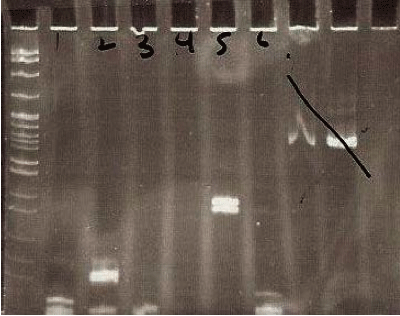
What do we know from these 2003 tests?
We know that:
(1) The DNA in both samples was exceptionally well preserved after 900 years.
(2) The mitochondreal DNA recovery proved the Starchild's mother was undoubtedly human.
(3) The Starchild's nuclear DNA was viable, but not recoverable by human-only primers.
Combining the last two of those left only one stark and startling conclusion: By knowing the Starchild's mother was human, and by knowing its nuclear DNA was viable but not responding to human-only primers, that could only mean that the father was causing the primer keys to fail to find their specific human locks. The father wasn't entirely human!
Where do we go from here?
Since 2003, some extremely dramatic innovations have allowed for the tracking of almost all of the genetic code in a given sample -- human or non-human. Part of the rush to develop this technology was the analysis of Neanderthal DNA in an effort to see if they were closely related to present day humans. With billions of base pairs and markers to apply to a sample of DNA, the new process is lengthy and very expensive. But it can reveal how human like or non-human like a given sample is and it can finally resolve the nature of the non-human DNA that fathered the Starchild.
According to Lloyd Pye,
Those physical variations in the Starchild skull are facts, regardless of whether science is willing to confront them at this moment or not. And by utilizing the new specialized testing modality, those facts can produce results that cannot be dismissed, ignored, ridiculed, or disputed by anyone. Such results will be immutable, so scientists will -- like it or not -- have to accept them and deal with them, just as religion and government will have to accept and deal with them. There is no other alternative to the testing scenario. The Starchild was, and is, a human-alien hybrid with the incredible ability to create new history as big as history can ever be created.""
If you would like to help Lloyd Pye in his research, please contact him at www.starchildproject.com.
From: VIEWZONE
http://www.viewzone.com/starchild.html




No comments:
Post a Comment